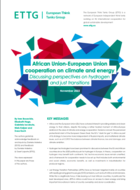Presentation
This Study analyzes the distributional impacts on European households of the proposed reform of the Energy Taxation Directive (ETD) and the Emissions Trading Scheme (ETS-2) as well as the proposed creation of a Social Climate Fund (SCF) funded by part of the revenues from the proposed ETS on road transport and buildings.
Key Messages
- The impact of the reduction in electricity taxes encouraged by the proposed reform of the energy taxation directive is progressive for households. If France simultaneously increases taxation on fossil fuels (gas, fuel oil, diesel, gasoline) to compensate for the loss of revenue from electricity taxes, the Commission's proposal has a positive average impact on the lowest 30 per cent of households, but the middle classes (deciles 4 to 8) and rural and peri-urban households are more strongly exposed to the increase in fuel prices. Translated with www.DeepL.com/Translator (free version)
- The combined direct impact of the DTE reform and the introduction of the ETS-2 on road transport and buildings with a CO2 price of 45 €/t is limited in France, but significant in many European countries. The French Social Climate Fund envelope mitigates the impact for all households and has an average positive impact for the lowest 50% of households if the redistribution of revenues is targeted towards these households. Translated with www.DeepL.com/Translator (free version)
- A CO2 price of 100 €/t (EU ETS-2 + national carbon tax) would have a stronger direct impact on the income of French households, especially for rural and peri-urban households and those in the middle class (deciles 4 to 8). If, in addition to the envelope proposed by the FSC, all revenues from the sale of allowances are redistributed to the lowest 50% of households, the average effect becomes positive for them, including rural and peri-urban households. Translated with www.DeepL.com/Translator (free version)
- A policy based on the polluter-pays principle seems possible for the building and road transport sectors in Europe. Nevertheless, significant heterogeneity remains in the impact of these measures on criteria other than income. This suggests that price control measures for the ETS-2 should be investigated to improve the predictability of the impact of these measures on the cost of fossil fuels, and that transition policies should be initiated now to target the lowest income groups most exposed to the increase in fossil fuel prices.





